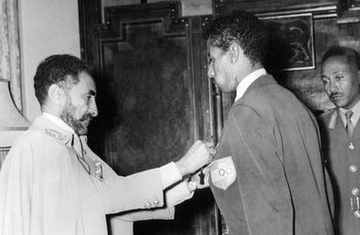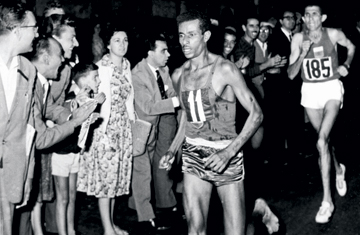
Above: Legendary Abebe Bikila returns home with Africa’s first
Olympic Gold Medal. Bikila returned to Ethiopia as a hero.
Emperor Haile Selassie promoted him to the rank of corporal
position in the Imperial Bodyguard, where he served, and
awarded him the Star of Ethiopia. (tessemas.net)
Abebe Bikila: Barefoot in Rome (Time)

FOOT SOLDIER: Running without shoes, Bikila, an
Imperial Guardsman in Ethiopian Emperor Haile Selassie’s court,
pulls ahead in the 1960 Rome marathon (Popperfoto/Getty)
By SIMON ROBINSON
Wednesday, Aug. 06, 2008
A few of the other runners sniggered when they saw Abebe Bikila turn up at the start of the Olympic marathon with no shoes. As a television camera scanned the scrum of athletes readying themselves for the starter’s gun, a commentator asked: “And what’s this Ethiopian called?” It was 1960, Rome. Africa was just shrugging off the weight of colonial rule and some sporting officials still doubted Africans were ready for the big time. A little over 2 hr. 15 min. later that myth lay shattered by the slight man wearing number 11, a member of Ethiopian Emperor Haile Selassie’s Imperial Guard and a proud African whose gliding, barefoot run through Rome’s cobblestone streets announced his continent’s emergence as a running powerhouse. Read More.


























what an atheltics he is the best
he is a hero for Ethopia
he must be proud of him self
god bless him
and let god give this can’d of people for Ethopia
god bless Ethopia